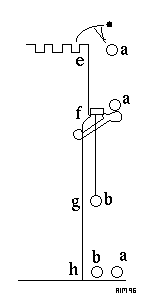McGuire and Tamny on the Two Falling Globes experiment
Newton's Two Falling Globes experiment is reproduced and discussed by McGuire and Tamny (henceforth Mc&T) along with the rest of his Questiones Quædam Philosophicæ (QQP p285, 428-9) This page outlines some disagreements I have with their commentary, and another page has some comments on the diagram and their version of it.Below is my transcription of Newton's words into modern spelling (the original with ``ye'' etc. is also available in context):
In the descent of a body there is to be considered the force which it receives every moment from its gravity (which must be least in a swiftest body) and the opposition it receives from the air (which increases in proportion to its swiftness). To make an experiment concerning this increase of motion, when the globe a has fallen from e to f, let the globe b begin to move at g so that both globes land together at h.
 Mc&T begin ``the definition of uniform acceleration - equal increments
of speed in equal increments of time. As a consequence of this definition,
he asserts that `in the descension of a body there is to be considered the
force which is receives every moment from it gravity - which must be least
in a swiftest body ...' ''. In fact, Newton does not refer to the definition
and he certainly does not use it to introduce his argument. On the previous
page is a mechanism for gravity, based on the descent of streams of tiny
particles which drag objects down by passing through their pores. Newton's
statement that gravity ``must be least in a swiftest body'' is a natural
consequence of this hypothesis, since the downward ``drag'' of the particles
would depend on the relative velocities and be less in a body already
falling.
Mc&T begin ``the definition of uniform acceleration - equal increments
of speed in equal increments of time. As a consequence of this definition,
he asserts that `in the descension of a body there is to be considered the
force which is receives every moment from it gravity - which must be least
in a swiftest body ...' ''. In fact, Newton does not refer to the definition
and he certainly does not use it to introduce his argument. On the previous
page is a mechanism for gravity, based on the descent of streams of tiny
particles which drag objects down by passing through their pores. Newton's
statement that gravity ``must be least in a swiftest body'' is a natural
consequence of this hypothesis, since the downward ``drag'' of the particles
would depend on the relative velocities and be less in a body already
falling.
Nevertheless, Mc&T continue ``consider two falling bodies; if one has a greater initial speed, it will cover a fixed distance in less time and thus will receive fewer increments of speed than the other.'' Although a true statement, Newton does not give this argument either. Mc&T then exclaim ``Newton seems to think that the one with less initial speed will reach a given point at the same time as the other!'' Obviously this can happen if they do not start falling from the same height.
Then follows an incorrect
description of Newton's diagram, which states that the descent of ball
a will ``release a blade that will free b at the
moment that a and b are abreast.'' Clearly the diagram
includes a string from f to g so that
a and b are not abreast when
b is released:
b receives a `head start' and so lands at the same time as
a, even though a is moving faster.
Mc&T accuse Newton of believing that a and
b land together on the basis of the ``foregoing `argument' '',
even though the `argument' owes little to Newton.
© 1994-1999 Andrew McNab. Back to newton.org.uk